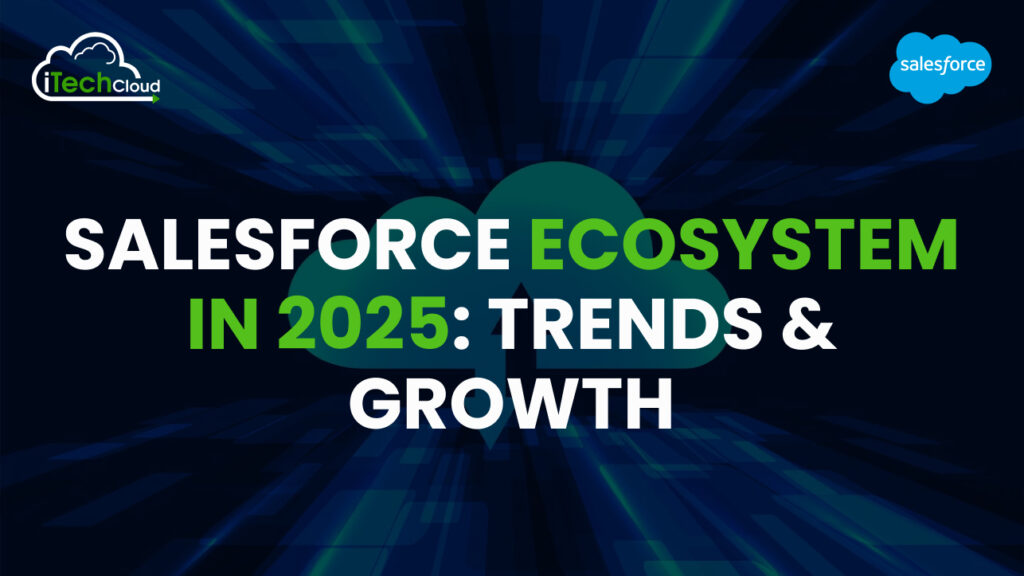Salesforce Ecosystem in 2025: Trends & Growth

Introduction
The Salesforce ecosystem is poised for transformative changes that will redefine how businesses operate and engage with customers. With advancements in artificial intelligence (AI), cloud technologies, and a focus on sustainability, Salesforce continues to innovate and adapt to the evolving digital landscape. This blog explores the key trends and growth opportunities within the Salesforce ecosystem for 2025, highlighting how organizations can harness these developments to stay competitive.
Table of Contents
What is Salesforce Ecosystem?
The Salesforce ecosystem refers to the integrated network of Salesforce products, services, and partners. It includes various cloud solutions like Sales Cloud, Service Cloud, Marketing Cloud, and more. The ecosystem also involves the AppExchange marketplace, Salesforce partners, developers, consultants, and users who contribute to building, customizing, and extending Salesforce capabilities. This collaborative environment helps organizations manage customer relationships and drive business growth.
Key Trends in the Salesforce Ecosystem in 2025
1. AI-Powered CRM Takes Center Stage
AI integration within Salesforce is becoming increasingly sophisticated, with tools like Salesforce Einstein GPT leading the charge. This technology enables businesses to leverage predictive analytics and hyper-personalized customer experiences, fundamentally changing how organizations interact with data and customers.
- Actionable Insights: Companies are encouraged to invest in AI features that automate repetitive tasks, enhance sales forecasting, and generate valuable insights.
- Training: Organizations should focus on training their teams to effectively utilize AI insights for improved decision-making.
- Customer Service: Implementing AI-driven chatbots can significantly enhance customer service capabilities, providing timely responses and support.
2. Automation with Flow
The automation capabilities of Salesforce are set to expand significantly in 2025. The introduction of more intuitive interfaces and enhanced orchestration capabilities will streamline workflows across various departments.
- Flow Enhancements: Businesses can expect improved automation tools that simplify complex processes, enabling teams to focus on strategic initiatives rather than routine tasks.
- Integration: Enhanced integration with external platforms will facilitate seamless operations across different cloud services, including AWS and Microsoft Azure.
3. Industry-Specific Clouds Gain Traction
Salesforce’s commitment to developing tailored solutions for specific industries is becoming more pronounced. The focus on vertical solutions will address unique challenges faced by sectors such as healthcare, retail, and manufacturing.
- Custom Solutions: By offering industry-specific clouds, Salesforce helps organizations achieve better adoption rates and results tailored to their operational needs.
- Market Demand: As businesses seek specialized tools that cater to their industry requirements, Salesforce’s industry clouds will likely see increased demand.
4. Data Cloud Takes Center Stage
In 2025, the Data Cloud will evolve into a central hub for real-time data activation and processing of unstructured data. This shift is crucial as organizations aim to leverage data for informed decision-making.
- Unified Customer View: Integrating Data Cloud with Customer 360 will provide businesses with a comprehensive understanding of customer interactions across all touchpoints.
- Real-Time Insights: Companies will be able to unlock real-time data insights, enhancing their ability to respond quickly to market changes.
5. Hyperforce Architecture Revolutionizes CRM
Salesforce’s Hyperforce architecture represents a significant advancement in cloud infrastructure. This cloud-native approach allows for faster deployments and improved scalability.
- Global Operations: Hyperforce enables organizations to operate seamlessly on a global scale while maintaining high performance and security standards.
- Infrastructure-as-Code: The transition from hardware-based to code-based infrastructure simplifies management and enhances flexibility.
6. The Rise of Agentforce
The introduction of Agentforce, Salesforce’s flagship AI-driven solution, marks a pivotal moment in automating complex business operations. This tool empowers organizations with autonomous AI agents capable of executing various tasks.
- Operational Efficiency: Agentforce can handle proposal creation, campaign planning, and strategic decision-making, significantly improving organizational efficiency.
- Implementation Challenges: While the benefits are substantial, businesses may face challenges during implementation that require careful planning and execution.
7. Omnichannel Customer Engagement
As customer interactions increasingly span multiple channels, Salesforce’s tools are evolving to provide unified experiences.
- Slack Integration: Deeper integration with Slack will streamline communication between teams and enhance collaboration with customers.
- Cohesive Campaigns: Innovations in the Marketing Cloud will enable businesses to create cohesive marketing campaigns across various platforms.
8. Focus on Sustainability and ESG Initiatives
Salesforce is placing a growing emphasis on sustainability and environmental, social, and governance (ESG) initiatives.
- Net Zero Cloud: Tools like Net Zero Cloud will empower businesses to measure and reduce their carbon footprints while aligning with global sustainability goals.
- Consumer Expectations: As consumers increasingly prioritize sustainability, companies integrating these values into their operations will likely see enhanced brand loyalty.
9. Expansion of the Salesforce Ecosystem
The Salesforce ecosystem encompasses a diverse range of partners, applications, and community contributions that drive innovation.
- AppExchange Growth: The AppExchange marketplace will continue to flourish, offering diverse solutions tailored to specific business needs.
- Collaboration Opportunities: Partnerships with technology leaders will facilitate the integration of cutting-edge functionalities into Salesforce.
The Growth for Salesforce Ecosystem in 2025
The Salesforce ecosystem in 2025 is poised for significant growth and transformation, driven by advancements in artificial intelligence (AI), strategic mergers and acquisitions (M&A), and a focus on data management. Here are the key predictions and trends shaping the landscape:
1. Strategic Mergers and Acquisitions
Salesforce is expected to intensify its M&A activities, leveraging its substantial cash reserves of $10 billion to acquire companies that enhance its AI capabilities and market reach. This strategy aims to integrate innovative technologies into the Salesforce platform, thereby improving service offerings and maintaining competitive advantage .
2. Rise of AI-Driven Solutions
The introduction of Agentforce, Salesforce’s flagship AI solution, is set to revolutionize business operations by automating complex tasks such as proposal creation and campaign planning. This shift towards autonomous AI agents reflects a broader trend where AI becomes integral to customer relationship management (CRM), enhancing efficiency and decision-making across industries like retail and nonprofits.
3. Data Management Innovations
Data will remain central to Salesforce’s strategy, with the Data Cloud evolving into a key resource for real-time data processing. This development will enable businesses to unlock actionable insights and improve customer interactions through better data governance and integration with platforms like Customer 360.
4. Hyperforce Architecture
Salesforce’s Hyperforce architecture will further transform the CRM landscape by enhancing scalability and deployment speed. This cloud-native approach is designed to minimize downtime and support global operations, making it easier for businesses to adapt to changing demands.
5. Job Market Dynamics
The Salesforce ecosystem is projected to generate approximately 11.6 million new jobs globally by 2028, contributing an estimated $2.02 trillion in business revenue. As companies invest in digital transformation, there will be a resurgence in demand for Salesforce professionals, particularly those with specialized skills in AI and automation.
6. Industry-Specific Solutions
Salesforce will continue refining its industry-specific solutions, catering to sectors such as healthcare, finance, and retail. This focus on tailored offerings will help businesses address unique challenges while driving adoption and delivering better results.
Conclusion:
The Salesforce ecosystem continues to thrive as a leading platform for CRM and business solutions. It is increasingly integrated with AI, automation, and advanced analytics, empowering businesses to enhance customer experiences and streamline operations. Salesforce’s growth is fueled by innovations in industries like healthcare, finance, and retail, with a strong emphasis on cloud-based solutions, data security, and scalability.
The Salesforce ecosystem also sees expanded use of low-code tools, enabling faster development and adoption. As companies prioritize digital transformation, Salesforce remains central to driving innovation and improving efficiency across diverse sectors.

